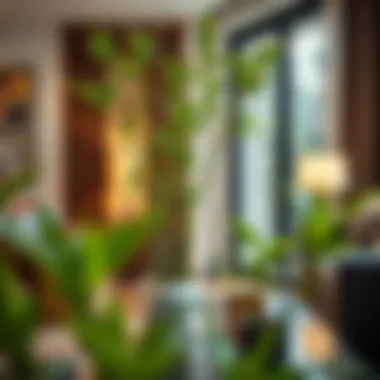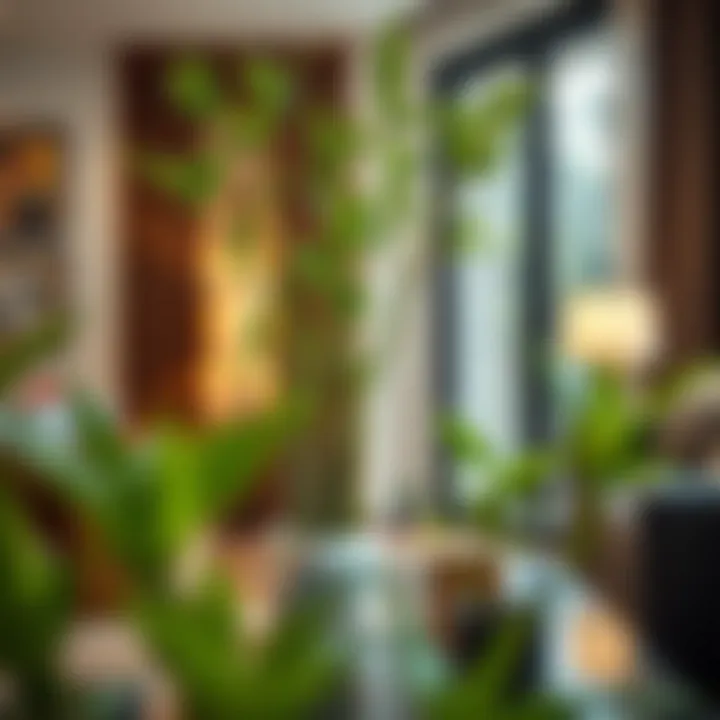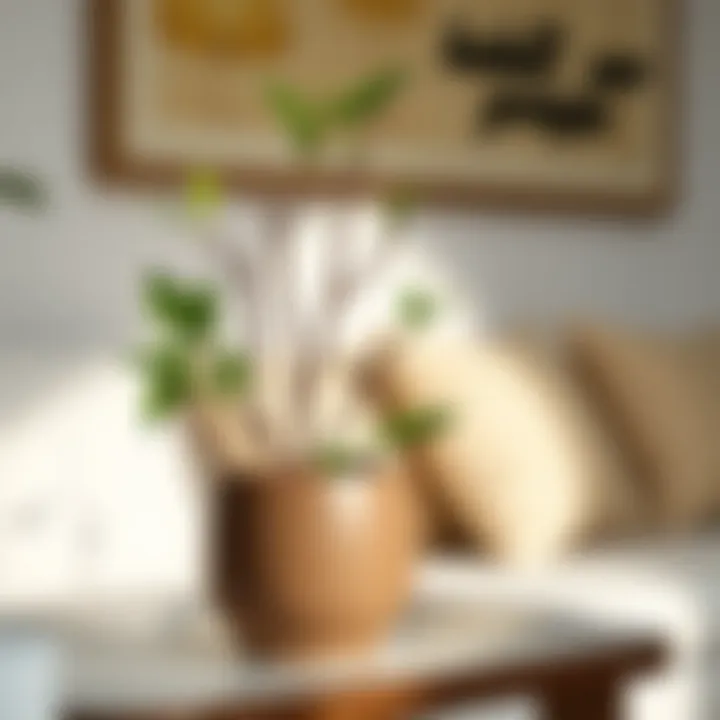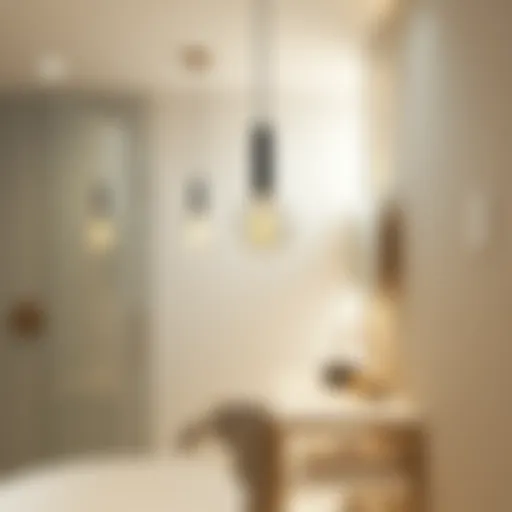The Ultimate Guide to Caring for Lucky Bamboo


Intro
The live lucky bamboo plant, often associated with good fortune and prosperity, has carved a niche for itself in the world of interior design and feng shui. This resilient plant, technically not bamboo but rather a species of Dracaena, offers an appealing blend of beauty and symbolic meaning, making it a popular choice among homeowners, designers, and feng shui enthusiasts alike. In this guide, we'll unravel the multifaceted aspects of lucky bamboo, covering its care requirements, interior design applications, and its significance in promoting positive energy within one’s living space.
Design Trends
Integrating live lucky bamboo into your home isn’t just a trend; it’s a movement reflecting a shift towards sustainable and aesthetically pleasing décor. The plant's lush green stalks and unique structure can enhance various interior styles, while its low-maintenance nature makes it a perennial favorite for busy individuals.
Current Trends in Furniture Styles
Recent trends in furniture design lean towards minimalism and natural materials. This is where lucky bamboo shines. Whether your space is adorned with mid-century modern pieces or contemporary finishes, the graceful lines of lucky bamboo can complement any aesthetic. Here are some ways it's being integrated:
- Bohemian style: Use lucky bamboo in patterned pots, surrounded by eclectic decor, to create an inviting atmosphere.
- Scandinavian design: Pair it with wood and neutral colors for a clean, airy feel.
- Industrial spaces: A stark contrast to metal and concrete elements, lucky bamboo offers warmth and a touch of nature.
How to Incorporate Trends into Your Space
To effectively use lucky bamboo in your home, consider the following:
- Groupings: Cluster different heights of bamboo for a more dynamic visual interest.
- Planters: Choose planters that resonate with your decor. For instance, ceramic pots can elevate a traditional style, while sleek glass adds to a modern look.
- Lighting: Position your lucky bamboo where it can receive indirect sunlight, which helps maintain its vibrant green color.
- Placement: Incorporate lucky bamboo in strategic areas, like entryways or living rooms, to invite positive chi into your home.
“Lucky bamboo is not just a plant, it’s a life philosophy woven into your living space.”
Incorporating lucky bamboo into your home design doesn't have to be complicated. A thoughtful selection based on your personal style will contribute significantly to both aesthetics and energy flow. As homeowners and designers look for distinctive elements to enrich their spaces, the live lucky bamboo plant stands out as a versatile choice, easily adaptable in various contexts.
Care Essentials
Understanding the care essentials for lucky bamboo can further enhance its contribution to your indoor environment.
- Water: Keep the soil consistently moist but not soggy, and use distilled or filtered water when possible.
- Light: Provide indirect light for optimal growth; too much direct sunlight can scorch the leaves.
- Fertilizing: Feed your plant with a diluted liquid fertilizer during its growing season, usually spring and summer.
- Pruning: Regularly trim yellow or dead leaves to encourage growth and maintain its health.
In this detailed examination, we will look closer into how to select, maintain, and best utilize this unique plant, positioning it as more than mere decor but a symbol resonating with auspicious attributes. The following sections will untangle the rich symbolism behind lucky bamboo, its practical care tips, and its potential to spruce up your interior spaces.
Understanding the Lucky Bamboo Plant
The lucky bamboo plant, often seen adorning homes and offices, is more than just a pretty face. Understanding this plant involves grasping its botanical designation, cultural roots, and the different varieties it boasts. Learning about these factors can significantly enhance one’s appreciation and care for the plant, ensuring it flourishes in any setting. As homeowners and enthusiasts delve into the nuances of lucky bamboo, they uncover stories and practices that not only elevate the aesthetic appeal but also foster well-being and fortune within their spaces.
Botanical Classification
In the world of plant taxonomy, lucky bamboo isn’t technically bamboo at all. It belongs to the Dracaena genus, and its scientific name is Dracaena sanderiana. This plant is native to Central Africa and is widely recognized for its slender stalks and lush green leaves. The enticing appearance is not only suitable for casual displays but also serves as a strong component in many households' decor. The plant prefers indirect light and can grow in both water and soil, making it adaptable to various environments while appealing to both novice and seasoned plant parents.
Cultural Significance
Symbolism in Feng Shui
In Feng Shui, lucky bamboo is shrouded in meaning. It symbolizes good fortune, prosperity, and positive energy flow. The number of stalks presents different meanings; for example, two stalks represent love, while three are said to bring happiness. This layered symbolism makes the plant appealing for those practicing Feng Shui; its mere presence is believed to attract beneficial energy. People seeking to enhance the vibe of their living environments often turn to lucky bamboo, valuing it as a means of promoting balance and harmony.
Historical Context
Historically, lucky bamboo has roots in ancient Chinese culture, where it was revered as a plant of longevity and resilience. It’s said to grant wishes and has often been a part of ceremonial practices. Over time, its popularity spread to other cultures and regions, each adding their own interpretations and uses. This rich history contributes to the plant's allure, as it embodies centuries of tradition and the collective hopes of countless individuals.
Varieties of Lucky Bamboo
When one mentions lucky bamboo, they might envision a singular style, but there’s a whole spectrum of varieties that can enhance the appeal.
Common Varieties
The most popular variety is the straight lucky bamboo, often sold in stores and commonly used in home decor. However, spiral lucky bamboo is gaining traction, featuring twisted stalks that create a dynamic visual effect. These common varieties act as conversation starters, easily adaptable to various decor styles. Their resilience and ease of care make them an ideal choice for beginners, yet they offer aesthetic depth even for interior design veterans.
Less Known Types


Diving deeper, there are less known types such as the ‘golden’ variety, which is characterized by its slightly thicker stalks and pronounced color variation. Then there’s the ‘curly’ variety, which showcases a unique twisting form that captures attention. These rare types can spark curiosity and elevate the design quality of any space, although they might demand more specialized care than their more common counterparts. Exploring these variants not only educates one about the plant but also enriches the decor through diversity.
Care Requirements for Live Lucky Bamboo
Caring for the live lucky bamboo plant is not just about keeping it alive; it’s about ensuring it thrives and enhances its environment. This plant is often linked to prosperity, making its cultivation vital for those who believe in its good fortune benefits. Understanding the care requirements can also unlock a deeper appreciation of this unique species. Proper care can lead to a long-lasting healthy plant that brings both beauty and positive energy to any space.
Optimal Growing Conditions
Creating the right environment is essential for lucky bamboo to flourish. This plant prefers warm, humid conditions, ideally between 65°F and 95°F (18°C to 35°C). It is sensitive to temperature fluctuations, so keeping it away from drafty areas or sudden temperature changes is wise. While lucky bamboo can grow in direct sunlight, it prefers bright, indirect light as its leaves can scorch under too strong rays.
Aditionally, humidity plays a big role. If the air in your home is dry, especially in winter, consider misting the plant or placing it on a pebble tray filled with water. This will not only keep it happy but can also encourage growth.
Watering Practices
Best Water Types
When it comes to watering your lucky bamboo, the type of water you use can make a significant impact. It’s important to avoid using tap water, as it often contains chlorine and other chemicals that can be harmful. Distilled water, rainwater, or filtered water are the best options you can provide for your lucky bamboo. Rainwater stands out as a natural, nutrient-rich choice, ensuring your plant gets pure water without the additives, which contribute positively towards growth.
- Chlorine-free benefits: By using the right water type, you're helping to maintain the plant’s health while steering clear of any potential toxicity that may stunt growth.
- Enhanced nutrient uptake: Clean and chemical-free water enhances the overall absorption of nutrients, resulting in a more vibrant plant.
Water Levels and Frequency
Managing the water level and frequency of watering is crucial for maintaining the health of your lucky bamboo. A good rule of thumb is to keep the roots submerged, while ensuring the water doesn’t cover the leaves. Typically, lucky bamboo requires water changes every two weeks for optimal health. It is essential to check the water level regularly; if you notice it below the indicated level, either top it up or change the water altogether.
- Monitoring frequency: Regular checks and changes not only prevent stagnation but also help avoid unwanted algae growth which can occur in confined spaces.
- Sign of distress: If the leaves yellow or droop, it could indicate either over-watering or under-watering. Adjusting accordingly based on plant feedback ensures longevity.
Fertilization Techniques
Though lucky bamboo does not require heavy feeding, it can benefit from occasional fertilization. When using fertilizer, it’s imperative to choose a diluted liquid fertilizer specifically designed for houseplants or one that is low in nitrogen. A quarter strength solution every couple of months is generally sufficient.
This minimal approach prevents the roots from becoming burnt and helps maintain a well-balanced nutrient profile, promoting healthy growth without overwhelming the plant.
Pest Management
Common Pests
Just like any other plant, lucky bamboo can be susceptible to pests such as aphids, spider mites, and mealybugs. These pests can cause damage, leading to nutrient deficits and unhealthy foliage. Keeping an eye on your plant for any signs of infestation is key. Reducing humidity levels can help deter these creatures. If you spot any pests, you can wipe them off with a soft cloth dipped in soapy water or use an insecticidal soap.
- Early detection: Regular checks can prevent small issues from blossoming into larger problems, ensuring the health of your plant over time.
- Natural predators: Attracting beneficial insects like ladybugs in your garden can also keep pest populations under control.
Preventative Measures
The best strategy for managing pests is prevention. Good hygiene around the plant's environment, such as avoiding overcrowding and ensuring proper air circulation, is crucial. Additionally, washing the leaves occasionally helps remove dust and any potential pests.
Another effective method is to rotate your plant periodically. This simple act can ensure even sunlight distribution, which can deter certain pests attracted to overexposed areas.
Repotting and Propagation
Repotting is necessary every couple of years to prevent root crowding and to refresh the growing medium. When repotting, choose a pot that is slightly larger and change the water medium if necessary. Propagation can be done by cutting a healthy stalk and placing it in water. With proper care, the new growth can lead to a flourishing addition to your collection.
Understanding these care requirements for the live lucky bamboo plant ensures its health and promotes its best features. By carefully managing its growing conditions, watering practices, fertilization, pest management, and occasional repotting, you’re not just keeping a plant alive, but fostering a symbol of prosperity that enriches your living space.
Styling with Lucky Bamboo in Home Decor
Lucky bamboo is more than just a plant; it’s a versatile decorative element that can significantly enhance your living spaces. Incorporating lucky bamboo into home decor not only elevates the aesthetic but also nods to its symbolic significance. When styled correctly, this plant can blend seamlessly into various design philosophies, making it a popular choice among homeowners and designers alike. Some folks believe that it attracts good fortune and prosperity, which adds another layer of appeal when inviting this plant into your home.
Integration in Interior Design
Modern Spaces


In modern settings, lucky bamboo shines by virtue of its minimalist appeal. These spaces often celebrate clean lines and uncluttered visuals, and lucky bamboo fits right in. The tall straight stalks bring a fresh touch, providing a stark contrast to straight-edged furniture or sleek designs with soft curves. Homeowners who prefer a polished look often use lucky bamboo in geometric vases that echo their existing decor.
The simplicity of lucky bamboo complements the modern aesthetic without overshadowing it. For instance, placing a slender lucky bamboo arrangement on a coffee table or a dining surface can create a harmonious focal point. However, one should consider that while it showcases vibrancy, the plant requires ample light to thrive. Thus, placing it near a window could be beneficial.
Traditional Setups
When it comes to traditional spaces, lucky bamboo serves as a bridge between old and new. The classic aesthetics often feature rich textures and ornate details, while lucky bamboo injects a sense of renewal. It represents nature’s bounty, adding an organic vibe that floral arrangements sometimes miss. Placing lucky bamboo in wooden planters or ceramic pots reflects the earthy palette commonly found in traditional homes.
This plant can further enhance the ambiance of a room filled with antiques, highlighting their character while keeping the air lively. If you're leaning toward traditional decor, positioning lucky bamboo near elements like vintage furniture can evoke a sense of history and stability.
Placement for Good Fortune
Entryways
The entryway is considered one of the best spots for lucky bamboo, greeting anyone who walks through the door with positivity. Many believe that placing this plant near the entrance promotes prosperity that flows into the home. The tall and upright growth of lucky bamboo creates an inviting atmosphere, potentially setting a positive tone for what lies within.
Moreover, it draws the eyes upward, lengthening the perceived height of the space which can be particularly advantageous in a smaller entry. However, it’s essential to maintain a balance and ensure that it doesn’t overwhelm the area; after all, first impressions can matter a lot.
Home Offices
In a home office, incorporating lucky bamboo can offer both aesthetic appeal and psychological advantages. Studies suggest that surrounded by greenery can boost creativity and reduce stress, making lucky bamboo an ideal companion for workspaces. Placing a small arrangement on your desk or shelf can not only brighten the area but also symbolize growth and success, perhaps motivating you as you tackle your daily tasks.
The sleek design of lucky bamboo can gel well with contemporary office setups or even rustic desks. Just keep in mind that it thrives under indirect light, so check how much sunlight your workspace receives to optimize its placement.
Living Areas
The living room usually serves as the heart of the home, and lucky bamboo fits snugly into this essential gathering space. By incorporating lucky bamboo in your living area, you encourage feelings of harmony and balance. Whether you want to create a serene corner or a lively display, lucky bamboo can cater to it.
Arranging it on a plant stand or in a decorative pot can also enhance visual interest without bulky arrangements. Just the right amount of lucky bamboo can bring a dash of tranquility to an otherwise bustling hub within the home.
The Aesthetic Appeal
Complementing Furniture Styles
Lucky bamboo stands out for its adaptability when it comes to complementing various furniture styles. It can either brighten a minimalist space or add warmth to classic interiors, making it an exceptionally versatile choice. When using lucky bamboo, think about the style dialogue it creates with your existing furniture. For example, pairing light-colored bamboo with dark wood can create a striking contrast that catches the eye.
Using lucky bamboo as an accent piece around furniture enhances the overall vibe of the room. That being said, choosing the right pot or container can also elevate the plant’s impact, highlighting the characteristics of your decor.
Color Schemes and Textures
The neutral green of lucky bamboo works wonders, easily blending into various color palettes. Whether your decor celebrates earthy tones or bold colors, lucky bamboo can be a harmonious addition. The texture of the bamboo itself adds depth, especially in spaces filled with different textiles.
Integrating lucky bamboo invites a natural feel without overpowering existing hues and can soften the overall aesthetics of a room. However, avoiding competing elements might be key here, as too many contrasting styles can muddle the intended essence.
Incorporating lucky bamboo is not just about aesthetics; it can bring a sense of peace and prosperity into your residing spaces.
The Benefits of Having Lucky Bamboo
Lucky bamboo isn’t just a pretty face in the world of houseplants. This resilient plant brings along a plethora of advantages that go beyond mere aesthetics. The benefits it offers touch both our physical environment and our mental well-being, making it a sought-after plant for homeowners, designers, and those looking to enhance their everyday spaces.
Psychological and Environmental Benefits
Stress Reduction
When it comes to stress, lucky bamboo stands out as a natural ally. The presence of this greenery can help calm the mind and create a serene environment. Studies suggest that being around plants, particularly those like lucky bamboo, can significantly lower cortisol levels, which are commonly known as the stress hormones. With its lush, vibrant green leaves and easy-going nature, lucky bamboo becomes more than just a decorative element; it’s a breathing companion in the quest for relaxation.
Its key characteristic lies in its simplicity of care. Unlike many plants that may require high maintenance, lucky bamboo thrives with minimal attention, thus allowing individuals to focus on professional and personal demands while still enjoying the benefits of having greenery around. Moreover, its unique feature of growing in water adds to its low-maintenance appeal, making it less stressful for those who aren’t naturally green-thumbed. The sheer act of caring for a lucky bamboo might even enhance one’s mood, thus weaving a thread of contribution to overall mental health.
Air Purification


An often overlooked benefit of lucky bamboo is its natural ability to purify the air. This plant is quite adept at filtering out harmful toxins that can linger in various indoor environments. Whether it's your home office, living room, or even a tiny apartment, having lucky bamboo around can contribute to a fresher, cleaner atmosphere.
The key characteristic of air purification stems from its capacity to absorb carbon dioxide and release oxygen during photosynthesis, a process vital for supporting life. It’s particularly effective at removing common pollutants, which can lead to a noticeable improvement in indoor air quality. With unique feature of being capable of thriving in low light and humidity, lucky bamboo can be successfully placed in areas where many plants might not survive. This makes it not just an attractive choice but also a practical one for enhancing your indoor environment.
Symbolic Advantages
Prosperity and Wealth
In cultures around the globe, lucky bamboo is often associated with prosperity and wealth. This plant is believed to attract positive energies associated with growth, financial success, and overall abundance. The number of stalks in a lucky bamboo arrangement can symbolize different fortunes; for instance, three stalks typically represent happiness, wealth, and long life.
Its key characteristic is how it integrates symbolism seamlessly into home design. This means that by placing lucky bamboo in strategic locations, individuals can align their living spaces with their aspirations for prosperity. This belief is deeply rooted in Feng Shui principles, wherein positioning the plant correctly can supposedly invite greater fortune to one’s living space.
Moreover, the unique feature of these plants being relatively easy to access and maintain allows more people to incorporate them into their lives. This accessibility has led to a surge of popularity among those who wish to attract good financial energy without much effort.
Health and Longevity
The notion that lucky bamboo contributes to health and longevity isn’t entirely baseless. The presence of plants in living spaces has been linked to improved mood and even physical health benefits. Lucky bamboo, with its ability to grow robustly, signifies strength and stability, further enhancing these themes of health and longevity in life.
Its key characteristic of resilience—capable of adapting to various environments—mirrors a broader theme of thriving against challenges, which can serve as a motivational symbol for individuals. Keeping lucky bamboo in your living space might thus encourage a mindset geared towards personal growth and well-being.
The unique feature of this plant, particularly in its ability to thrive where conditions are not optimal, makes it an inspiring option for those seeking to promote health in their surroundings. Its appearance alone can act as a daily reminder of vitality.
"Lucky bamboo isn’t merely a decorative accessory; it symbolizes prosperity and health while actively enhancing the environment we live in."
In summary, the benefits of having lucky bamboo reach far beyond its beauty. It offers psychological and environmental gains while carrying rich symbolic meaning that resonates deeply with many individuals. It’s not just a plant; it’s a companion on the journey for a balanced, prosperous life.
Common Misconceptions about Lucky Bamboo
Lucky bamboo, despite its name, isn't actually bamboo at all; it is a member of the Dracaena family. Understanding these common misconceptions is vital because it can drastically affect how one chooses to care for this plant, as well as the expectations set around its benefits and growth. Clearing up these myths aids both homeowners and enthusiasts in making informed decisions and avoiding frustration in their journey with this captivating plant.
Myths vs. Facts
One of the most prevalent misconceptions surrounding lucky bamboo lies in its supposed simplicity of care. Many believe that since it’s often seen thriving in water, it requires little to no maintenance. However, while lucky bamboo is forgiving, it does have specific needs that must be met for it to flourish.
- Myth: Lucky bamboo thrives in plain water without any nutrients.
Fact: While it can survive in water alone, providing a diluted liquid fertilizer every few weeks can promote healthier growth. - Myth: All lucky bamboo brings good fortune.
Fact: The arrangement and number of stalks can influence the blessings associated with them in Feng Shui. - Myth: Lucky bamboo is dangerous to pets.
Fact: It is considered non-toxic to cats and dogs, which is a relief for many pet owners.
"Understanding the truths about lucky bamboo can not only enrich your experience with the plant but also align it more closely with the benefits you seek."
By grasping these truths, care practices become more effective, leading to more joyful gardening.
Cultural Interpretations
The cultural significance of lucky bamboo extends far beyond mere aesthetics. Its use in varying cultures gives rise to interpretations that often clash with one another.
- In Chinese culture, lucky bamboo is deeply intertwined with Feng Shui concepts. The number of stalks symbolizes different blessings:
- In Western societies, lucky bamboo sometimes gets marketed as an ornamental piece devoid of cultural anchoring. This can dilute its true meaning, as its benefits are largely seen through a lens of aesthetic appreciation rather than spiritual connection.
- Global perspectives often mistakenly homogenize its meanings. In some areas, lucky bamboo is merely a decorative piece without knowledge of its intended purpose within Feng Shui practices.
- Two stalks symbolize love and marriage.
- Three stalks represent happiness, wealth, and longevity.
- Five stalks are believed to attract all five elements, contributing to balance.
Understanding these cultural interpretations not only elevates one’s appreciation of lucky bamboo but also aids in respectful integration into spaces that honor its traditions.
In summary, addressing these common misconceptions informs caretakers and decorators alike, enriching their connection to the live lucky bamboo plant and ensuring that its rich legacy is honored within their homes.
Ending
In wrapping up our exploration of the live lucky bamboo plant, it’s essential to reflect on the myriad elements that contribute to its esteemed position within both horticulture and interior design. The lucky bamboo serves not only as an eye-catching addition to any home but also as a symbol rich with cultural significance and potential benefits, particularly in the context of feng shui. Its simplicity and adaptability make it a favorite among homeowners and interior designers alike, presenting opportunities to bring nature into varied living spaces.
The benefits of incorporating lucky bamboo into your environment stretch beyond aesthetics. Many enthusiasts claim it brings prosperity and good fortune, echoing the sentiments of generations who have revered this plant for its purported ability to harness positive energy. It’s crucial to not overlook the psychological benefits either; caring for plants like lucky bamboo can significantly reduce stress, providing a calming influence amid our often hectic lives. Moreover, when one considers its air-purifying qualities, the advantages appear multifaceted—offering both immediate gratification and long-term wellness.
A few considerations stand out while integrating lucky bamboo into your decor. First off, understanding its care requirements is paramount; different varieties may demand slightly different levels of light and water. Secondly, placement holds significant weight, as the positioning can influence how well the plant embodies its symbolic role in feng shui. As such, deliberation on where to situate your lucky bamboo is not merely a matter of preference but can be tied deeply to the energy flow within your living space.
By summarizing the core aspects discussed—from essence and care practices to decor integration—the lucky bamboo emerges as a perennial ally for enhancing both the functionality and the aesthetic appeal of your home. As you explore this fascinating plant, remember that whether you consider it a simple decorative piece or a powerful talisman for good fortune, its presence can undoubtedly spark joy within your space.
"Lucky bamboo is not just a plant but a bridge to serenity, prosperity, and sustainable beauty in the home."
To delve deeper into the significance of lucky bamboo, keep an eye on resources such as Wikipedia or Britannica for historical and scientific insights. For discussions on incorporating plants into interior design, platforms like Reddit might also offer valuable community perspectives.















